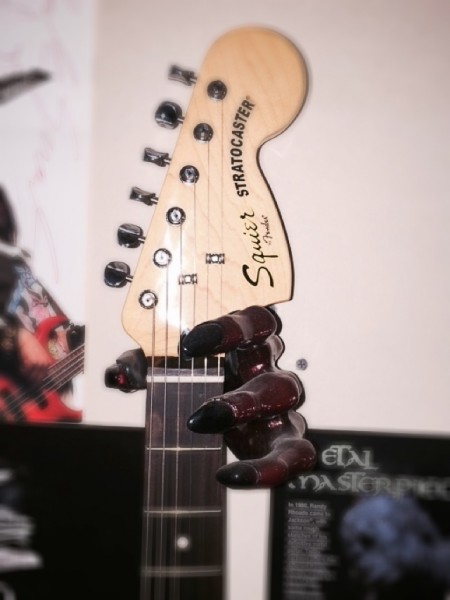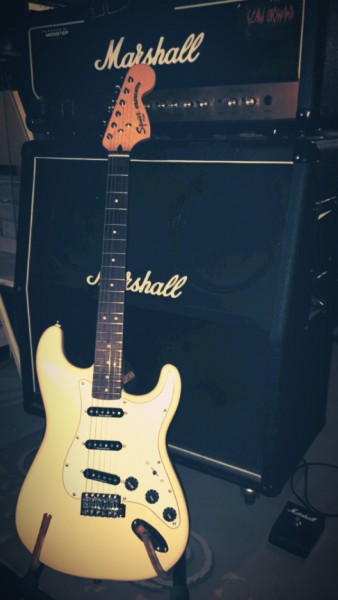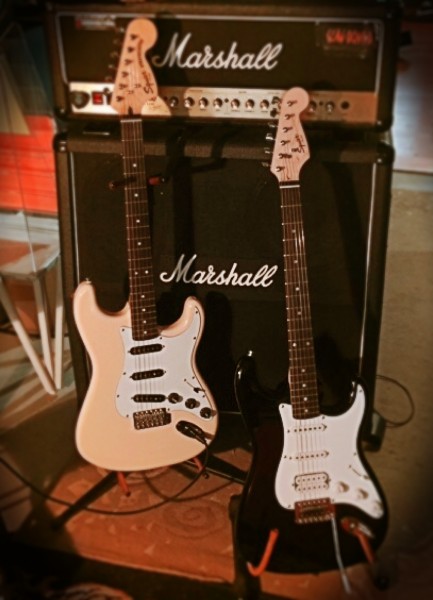 I had an interesting conversation not that long ago with another guitar player about the “cheap” brand versus “premium” brand that guitar manufacturers produce. With Gibson for instance, while you can purchase a new Les Paul with the Gibson branding for anywhere from $800 to upwards of $5000, Gibson also produces the Epiphone brand that will get a Les Paul hanging from your neck starting in the $250 range. So in our conversation I mentioned that while I’ve never owned a Les Paul, the best feeling one I’d ever played happened to be an Epiphone, albeit a special series. Despite this, however, my argument was that I could not purchase the lower branded guitars. I would always buy a Gibson before an Epiphone, an ESP before an LTD, or a Fender before a Squier. Sure, they are made from better materials with better craftsmanship (for the most part) but as we talked I began to realize the primary reason was simply appearance. I had to admit that a few of the “sub” brands make really great guitars and thus I guess I really just wanted people to see Fender on the headstock and not Squier. The irony of this is that not 2 months later I picked up a new LTD guitar. Plays and sounds great and while I have long wanted an ESP Eclipse, this allowed me to have a beautiful instrument for significantly less money. I had owned a Squier Strat in the past as someone gave it to me but it was certainly down my pecking order of guitars to pick up and play. I eventually gave the Squier to my son when he wanted to start playing and when he gave up playing, I never saw the guitar again. I think it is fair to say that things have changed at Fender as these two Squiers seem infinitely more enjoyable to play than my old one.
I had an interesting conversation not that long ago with another guitar player about the “cheap” brand versus “premium” brand that guitar manufacturers produce. With Gibson for instance, while you can purchase a new Les Paul with the Gibson branding for anywhere from $800 to upwards of $5000, Gibson also produces the Epiphone brand that will get a Les Paul hanging from your neck starting in the $250 range. So in our conversation I mentioned that while I’ve never owned a Les Paul, the best feeling one I’d ever played happened to be an Epiphone, albeit a special series. Despite this, however, my argument was that I could not purchase the lower branded guitars. I would always buy a Gibson before an Epiphone, an ESP before an LTD, or a Fender before a Squier. Sure, they are made from better materials with better craftsmanship (for the most part) but as we talked I began to realize the primary reason was simply appearance. I had to admit that a few of the “sub” brands make really great guitars and thus I guess I really just wanted people to see Fender on the headstock and not Squier. The irony of this is that not 2 months later I picked up a new LTD guitar. Plays and sounds great and while I have long wanted an ESP Eclipse, this allowed me to have a beautiful instrument for significantly less money. I had owned a Squier Strat in the past as someone gave it to me but it was certainly down my pecking order of guitars to pick up and play. I eventually gave the Squier to my son when he wanted to start playing and when he gave up playing, I never saw the guitar again. I think it is fair to say that things have changed at Fender as these two Squiers seem infinitely more enjoyable to play than my old one.
Quick joke here and my wife will attest to its veracity. How many guitars does a guitar player need? One more!

If you’ve been longing for that American made Fender Stratocaster, by all means keep saving because it is an incredible beast of a guitar, but in the meantime don’t overlook a Fender Squier because the value you get for your dollar is virtually unrivalled. I will look at two Squier Stratocaster models today. The first is the entry level Squier Bullet and the second is the step up Squier Vintage 70s Modified Stratocaster. I will give you an overview of their construction, talk about playability and tone, and then try and frame all of this while considering value.
Squier Bullet
The less expensive of the two guitars looked at here, the Bullet is marketed as designed for “beginners and students” which is frankly an apt description. It has the famed Stratocaster body design, albeit significantly slimmer than your standard Strat, and is a basswood body. Basswood is an inexpensive wood that is light but generally offers a “meaty” tone and doesn’t get too bright sounding. The neck is made of maple, it has a rosewood fingerboard, and sports 21 jumbo frets. This is particularily good for beginners as the larger frets make it easier to cleanly sound out notes and chords as you don’t have to press as hard on the strings which should help avoid getting discouraged early in the learning process. As you advance it will also assist with newer techniques like bending and vibrato. The Bullet also has two single coil pickups and one humbucker. As a very general rule, humbuckers have a fatter sound than a single coil but with both varieties on one guitar, you really have a lot of choice when it comes to tones. Now, having said that, at this price point while you are getting acceptable pickups, you certainly won’t be getting top of the line models which easily sell on their own for more than this guitar. The bullet also has a tremolo bar (or a whammy bar as it is often called) although without a locking nut or some reasonable facsimile, doing a dive bomb will significantly affect your tuning so be aware. This doesn’t mean that it isn’t a fun little tool though.
Squier Vintage 70s Modified Stratocaster
 While the overall look of these guitars are almost identical, there are some significant differences. The Vintage 70s Modified Strat has a larger headstock, a thicker neck and body, and three single coil pickups that allow it to immediately stand out as different than the Bullet. The overall design is based on the 1970s Stratocaster with chrome tuning pegs and hardware, an engraved neck plate, black numbered control knobs, and a gloss neck with white rosewood fingerboard, all of which harkens back to the sought after Fenders of yesteryear. It also has a basswood body and maple bolt on neck. Save for the Squier branding on the headstock, you’d be hard pressed to not think that this was the classic Fender Strat, especially from a distance. The neck also has 21 Medium/Jumbo frets. Whereas the Bullet is made in China, this model is constructed in Indonesia which is known as producing a higher quality axe than their Chinese counterparts.
While the overall look of these guitars are almost identical, there are some significant differences. The Vintage 70s Modified Strat has a larger headstock, a thicker neck and body, and three single coil pickups that allow it to immediately stand out as different than the Bullet. The overall design is based on the 1970s Stratocaster with chrome tuning pegs and hardware, an engraved neck plate, black numbered control knobs, and a gloss neck with white rosewood fingerboard, all of which harkens back to the sought after Fenders of yesteryear. It also has a basswood body and maple bolt on neck. Save for the Squier branding on the headstock, you’d be hard pressed to not think that this was the classic Fender Strat, especially from a distance. The neck also has 21 Medium/Jumbo frets. Whereas the Bullet is made in China, this model is constructed in Indonesia which is known as producing a higher quality axe than their Chinese counterparts.
Playbility & Tone
Straight out of their boxes and with the protective plastic still on, these guitars needed to be set up. They came equipped lighter gauge strings than I use but I left those on, stretched the strings and got both in tune. I played the Vintage Strat first and was actually a bit shocked at how full and meaty it felt just picking it up. Not heavy or overbearing by any means but it felt solid. It had a nice thick neck which kind of reminded me of my SG. As I started to play there was one thing that I was concerned about as it is one of the reasons I don’t always like to play Strats and that is that the posts on the single coils are often set quite high and I keep getting my pick caught on them. While this did happen occasionally with the Bullet, it never happened on the 70s Vintage. I was also impressed with some of the tones I could pull out of both of these. The 5 way toggle switch lets you mix up your pickup selections and all 5 positions generate some different feelings. Both the Bullet and the Vintage could get nice and warm sounds although the Bullet was clearly the brighter sounding of the two in the majority of pickup positions. When the humbucker was employed it definitely got beefier..

The small neck on the Bullet also made it quite easy to play. I don’t have the biggest hands in the world but they had no problems moving around the fretboard and stretching to reach notes on some trickier chords. I can certainly see how this guitar would be inviting to learn on as it doesn’t fight back at you, if anything it really invites you to delve into and explore. The slimmer body on the Bullet would also ease someone into playing as it isn’t cumbersome, whether on your lap or around your neck. Now a more advanced player will likely want to play the Vintage Squier Strat as it feels substantial, is very smooth to play, and to my ears anyway, was the better sounding of the two. It was fuller, had some more variance in the dynamics, and I prefer a beefier neck.
Bottom Line
As both of these certainly qualify as “budget” guitars, you really can’t go wrong with either. If you are just starting out then the Bullet certainly won’t break your bank and is far less likely to frustrate you as it really is accommodating to play. If you are an intermediate or established player the Squier Vintage 70s Modified Stratocaster is a great looking and sound and should certainly be given consideration. As I can never say enough apparently, don’t take my word for anything. Head down to your local BestBuy and audition these Squier Strats, as well as many others, so that you can pick the one that is right for you. Money is always a concern for us so make sure yours is being used in the most responsible way possible. Buying a guitar you love to play will pay you back in the end.



